Previous issue | Next issue | Archive
Volume 14 (1); March 25, 2024
|
|
Research Paper
Efficacy and Safety of an Inactivated Novel Variant Infectious Bursal Disease Virus in Broiler Chickens
Hair-Bejo M, Gauthaman L, Mazlan M, Sohaimi NM, and Ugwu CC.
J. World Poult. Res. 14(1): 1-11, 2024; pii: S2322455X2400001-14
DOI: https://dx.doi.org/10.36380/jwpr.2024.1
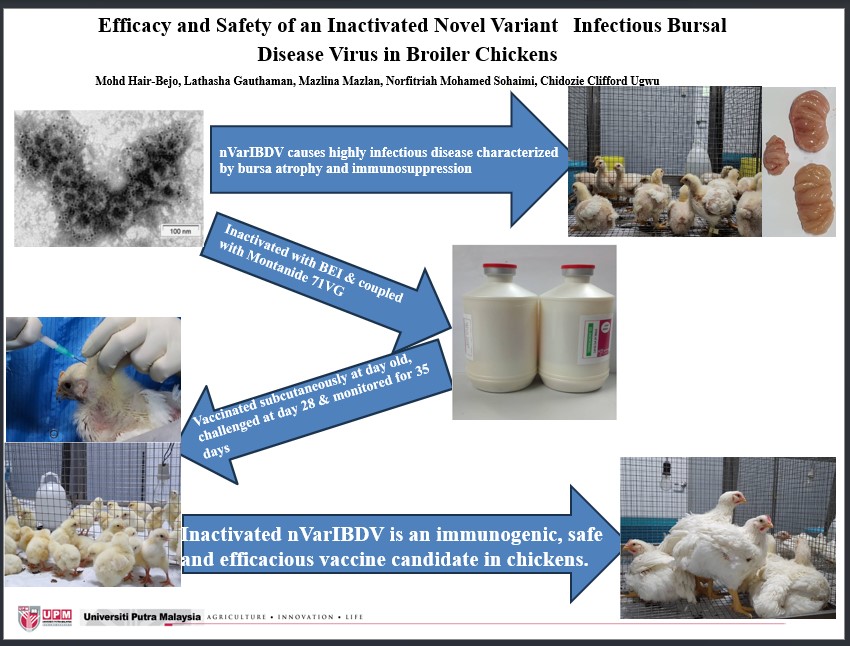 ABSTRACT: The infectious bursal disease virus (IBDV) is severe and highly contagious, causing high mortality and immunosuppression in chickens worldwide. A new novel variant, IBDV (nVarIBDV), has recently emerged in Asian countries, including Malaysia, highlighting the need to develop a new vaccine against this strain due to the inadequacy of existing commercial vaccines in protecting chickens from nVarIBDV infection. Therefore, the current study aimed to evaluate the efficacy and safety of inactivated nVarIBDV as a potential vaccine candidate in broiler chickens. A total of 65 one-day-old Arbo Acres broiler chickens were randomly divided into three groups (five animals in each group with four replications) before the challenge, namely A, B, and C. Groups A and B were immunized subcutaneously at day old with inactivated nVarIBDV (107 EID50/0.2 ml), and Group B was boosted at day 14. Group C was an unimmunized control. The experimental animals were divided into three subgroups and were challenged with pathogenic nVarIBDV (105 EID50/1.0ml) on day 28 post-inoculation through ocular and oral routes. The challenge sub-groups were named ACH, BCH, and CCH, respectively. The live body weight, bursa weight, and blood samples of the chickens were recorded. Gross lesions were examined, and samples of the bursa of Fabricius were collected from all the groups for histological evaluation. All the chickens appeared healthy and normal throughout the trial. Body weight increased in all groups without significant differences. The bursa weight and the bursa-to-body weight ratio of the booster group (Group B) were significantly higher than the non-booster and control groups. Gross lesions were not observed in the investigated groups. The challenged control group had higher bursa lesion scoring than the vaccinated groups. The IBDV antibody titer of challenged chickens in ACH, BCH, and CCH groups was higher than those of unchallenged groups A, B, and C at 35 days post-inoculation. The IBDV antibody titer of challenged chickens in group B was higher than challenged chickens in groups A and C (ACH and CCH). In conclusion, the inactivated nVarIBDV demonstrated safety and efficacy, with the booster Group (B) showing elevated humoral immune responses compared to the non-booster group.
ABSTRACT: The infectious bursal disease virus (IBDV) is severe and highly contagious, causing high mortality and immunosuppression in chickens worldwide. A new novel variant, IBDV (nVarIBDV), has recently emerged in Asian countries, including Malaysia, highlighting the need to develop a new vaccine against this strain due to the inadequacy of existing commercial vaccines in protecting chickens from nVarIBDV infection. Therefore, the current study aimed to evaluate the efficacy and safety of inactivated nVarIBDV as a potential vaccine candidate in broiler chickens. A total of 65 one-day-old Arbo Acres broiler chickens were randomly divided into three groups (five animals in each group with four replications) before the challenge, namely A, B, and C. Groups A and B were immunized subcutaneously at day old with inactivated nVarIBDV (107 EID50/0.2 ml), and Group B was boosted at day 14. Group C was an unimmunized control. The experimental animals were divided into three subgroups and were challenged with pathogenic nVarIBDV (105 EID50/1.0ml) on day 28 post-inoculation through ocular and oral routes. The challenge sub-groups were named ACH, BCH, and CCH, respectively. The live body weight, bursa weight, and blood samples of the chickens were recorded. Gross lesions were examined, and samples of the bursa of Fabricius were collected from all the groups for histological evaluation. All the chickens appeared healthy and normal throughout the trial. Body weight increased in all groups without significant differences. The bursa weight and the bursa-to-body weight ratio of the booster group (Group B) were significantly higher than the non-booster and control groups. Gross lesions were not observed in the investigated groups. The challenged control group had higher bursa lesion scoring than the vaccinated groups. The IBDV antibody titer of challenged chickens in ACH, BCH, and CCH groups was higher than those of unchallenged groups A, B, and C at 35 days post-inoculation. The IBDV antibody titer of challenged chickens in group B was higher than challenged chickens in groups A and C (ACH and CCH). In conclusion, the inactivated nVarIBDV demonstrated safety and efficacy, with the booster Group (B) showing elevated humoral immune responses compared to the non-booster group.
Keywords: Antibody, Chicken, Efficacy, Inactivated vaccine, Novel variant infectious bursal disease virus
[Full text-PDF] [Crossref Metadata] [Scopus] [Export from ePrints]
|
|
Research Paper
Effects of Palm (Elaeis Guineensis) Oil on Performance, Thermotolerance, and Welfare of Broiler Chickens in Heat Stress Condition
Yarkoa T, Songuine T, Kpomassé CC, Parobali T, Karou DS, and PItala W
J. World Poult. Res. 14(1): 12-22, 2024; pii: S2322455X2400002-14
DOI: https://dx.doi.org/10.36380/jwpr.2024.2
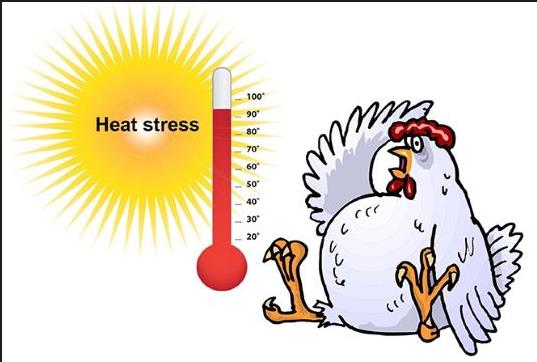 ABSTRACT: Heat stress negatively affects the broiler chickens’ productivity and well-being. This study was carried out to assess the effect of dietary palm oil inclusion on the growth performance, thermotolerance, biochemical parameters, and welfare of broiler chickens raised in tropical climates. A total of 500 broiler chickens aged 15 days were divided into four treatments, each consisting of five replicates with 25 chickens per replicate in a randomized design. The control group was fed a standard diet without palm oil (T), and the remaining diets contained palm oil at the inclusion levels of 1% (P1), 2% (P2), and 3% (P3). During the 4 weeks of experimentation, daily temperature and relative humidity in the poultry house were measured by thermo-hygrometers, and growth performance was weekly recorded. At 45 days old, six broiler chickens were slaughtered with measurements taken for carcass compositions and intestinal length. At 42 days of age, blood samples were collected for the Triiodothyronine (T3) and Thyroxine (T4) hormones, biochemical profiles, and Heterophil: lymphocyte (H/L) ratio assessment at the Regional Center of Excellence on Avian Sciences. Gait abnormality and litter quality were assessed at 38 days of age. The results indicated that the incorporation of 1% palm oil improved the growth performance of chickens compared to other groups. Similarly, the concentrations of T4 and T3 were higher in the 1% palm oil group. Triglycerides and total protein concentrations were higher in the broiler chickens of the control group, compared to other treatment groups. The dropping weight and gait score decreased with the increasing rate of palm oil. The results suggest that palm oil can be a beneficial dietary supplement for broiler chickens, particularly under heat-stress conditions. The incorporation of 1% palm oil contributes to the improvement of growth performance and the well-being of broiler chickens in tropical climates. However, it is crucial to consider the appropriate level of palm oil inclusion, as higher levels may have adverse effects, such as increased mortality.
ABSTRACT: Heat stress negatively affects the broiler chickens’ productivity and well-being. This study was carried out to assess the effect of dietary palm oil inclusion on the growth performance, thermotolerance, biochemical parameters, and welfare of broiler chickens raised in tropical climates. A total of 500 broiler chickens aged 15 days were divided into four treatments, each consisting of five replicates with 25 chickens per replicate in a randomized design. The control group was fed a standard diet without palm oil (T), and the remaining diets contained palm oil at the inclusion levels of 1% (P1), 2% (P2), and 3% (P3). During the 4 weeks of experimentation, daily temperature and relative humidity in the poultry house were measured by thermo-hygrometers, and growth performance was weekly recorded. At 45 days old, six broiler chickens were slaughtered with measurements taken for carcass compositions and intestinal length. At 42 days of age, blood samples were collected for the Triiodothyronine (T3) and Thyroxine (T4) hormones, biochemical profiles, and Heterophil: lymphocyte (H/L) ratio assessment at the Regional Center of Excellence on Avian Sciences. Gait abnormality and litter quality were assessed at 38 days of age. The results indicated that the incorporation of 1% palm oil improved the growth performance of chickens compared to other groups. Similarly, the concentrations of T4 and T3 were higher in the 1% palm oil group. Triglycerides and total protein concentrations were higher in the broiler chickens of the control group, compared to other treatment groups. The dropping weight and gait score decreased with the increasing rate of palm oil. The results suggest that palm oil can be a beneficial dietary supplement for broiler chickens, particularly under heat-stress conditions. The incorporation of 1% palm oil contributes to the improvement of growth performance and the well-being of broiler chickens in tropical climates. However, it is crucial to consider the appropriate level of palm oil inclusion, as higher levels may have adverse effects, such as increased mortality.
Keywords: Energy, Feeding strategies, Heat stress, Palm oil, Welfare
[Full text-PDF] [Crossref Metadata] [Scopus] [Export from ePrints]
|
|
Research Paper
Effects of Body Condition, Anatomical Measurement, and Age on the Cumulative Number of Individual Egg Production and Laying Pattern in First Laying Hens
Prayogi HS, Nurgiartiningsih VMA, Sjofjan O, and Suyadi.
J. World Poult. Res. 14(1): 23-29, 2024; pii: S2322455X2400003-14
DOI: https://dx.doi.org/10.36380/jwpr.2024.3
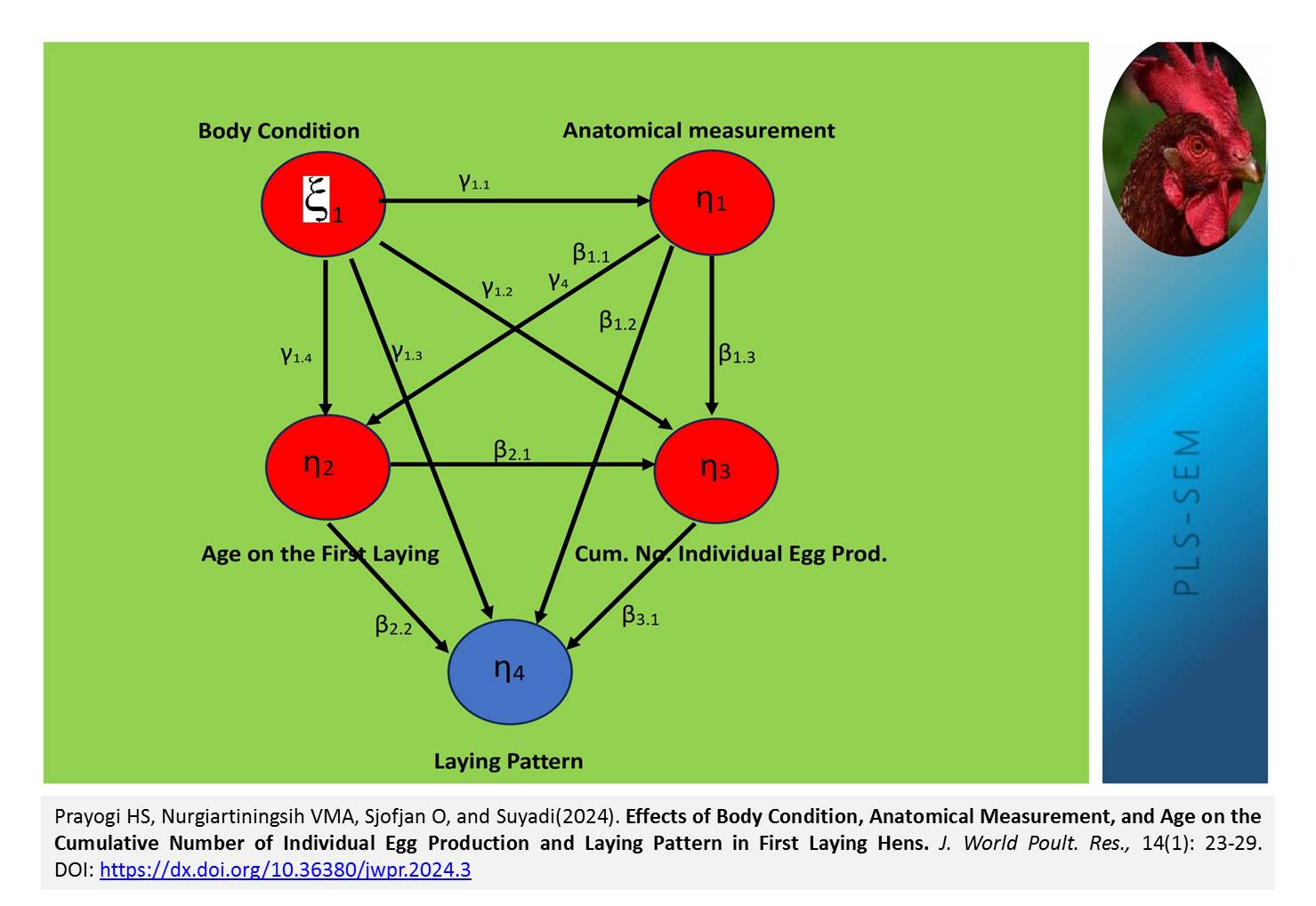 ABSTRACT: The individual egg production capacity of laying hens plays an outstanding role in achieving total production within a flock, which is affected by several internal and external factors. This study aimed to evaluate the effect of body condition, anatomical measurement, and age at the first laying (AFL) on the cumulative number of individual egg production (CNIEP) and laying pattern. Therefore, 172 Isa Brown laying chickens were investigated. Data on body condition and anatomical measurement were collected at the age of 16 weeks, while data on production was collected during 21 weeks of production (18-39 weeks). The obtained data were analyzed by Partial Least Square- Structural Equation Modeling (PLS-SEM) using smartPLS. The findings revealed that CNIEP could be predicted by body condition, anatomical measurement, and AFL. Compared to body condition and anatomical measurements, AFL was the most prominent factor in CNIEP. Body condition, anatomical measurement, AFL, and CNIEP had weak effects on the Isa Brown laying chickens’ patterns.
ABSTRACT: The individual egg production capacity of laying hens plays an outstanding role in achieving total production within a flock, which is affected by several internal and external factors. This study aimed to evaluate the effect of body condition, anatomical measurement, and age at the first laying (AFL) on the cumulative number of individual egg production (CNIEP) and laying pattern. Therefore, 172 Isa Brown laying chickens were investigated. Data on body condition and anatomical measurement were collected at the age of 16 weeks, while data on production was collected during 21 weeks of production (18-39 weeks). The obtained data were analyzed by Partial Least Square- Structural Equation Modeling (PLS-SEM) using smartPLS. The findings revealed that CNIEP could be predicted by body condition, anatomical measurement, and AFL. Compared to body condition and anatomical measurements, AFL was the most prominent factor in CNIEP. Body condition, anatomical measurement, AFL, and CNIEP had weak effects on the Isa Brown laying chickens’ patterns.
Keywords: Anatomical measurement, Individual egg production, Laying pattern
[Full text-PDF] [Crossref Metadata] [Scopus] [Export from ePrints]
Research Paper
Differential Gene Expression Profiling during Avian Immune Organ Development: Insights from Thymus and Bursa of Fabricius Transcriptome Analysis
El Helaly Goher MN, Moghaieb RE, El-Menawey MA-R, and Ramzy Stino FK.
J. World Poult. Res. 14(1): 30-40, 2024; pii: S2322455X2400004-14
DOI: https://dx.doi.org/10.36380/jwpr.2024.4
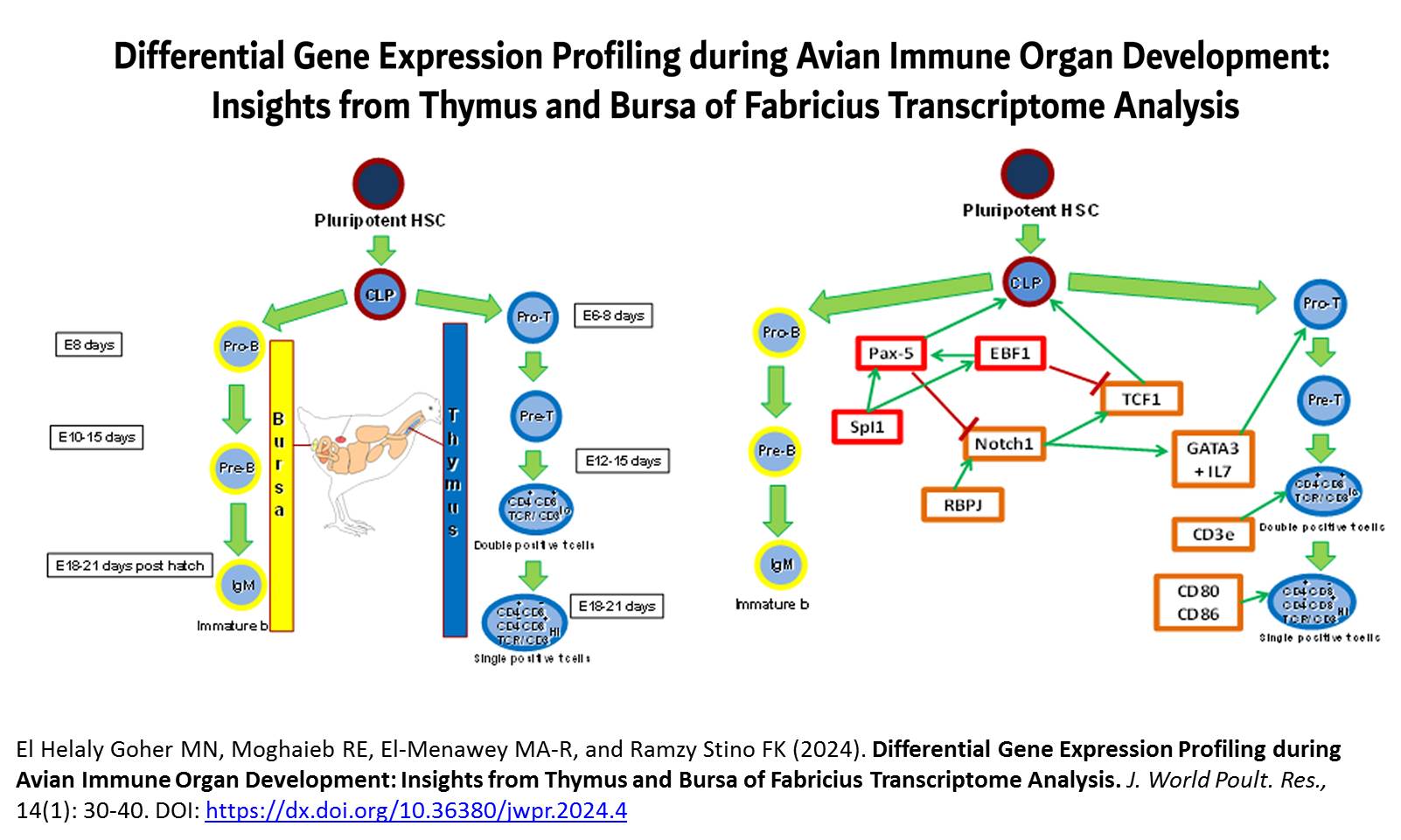 ABSTRACT: Pluripotent hematopoietic stem cells undergo maturation to regenerate blood cells. T-cell and B-cell maturation from common lymphoid progenitors (CLPs) is regulated by distinct transcription factors and signaling pathways. Notch signaling, GATA3, and TCF1 drive T-cell fate, while EBF1, PU.1, E2A, Pax5, TCF1, and Foxo1 regulate B-cell differentiation. Alterations in these factors can cause lineage deviations. Gene expression profiling of the chick thymus and bursa reveals dynamic expression patterns of transcription factors, cytokines, and signal molecules. Notch1 and Dll1 expression that increase during later stages indicate the ongoing role of Notch signaling in T-cell lineage maintenance. The current study aimed to identify differentially expressed genes during the development of the avian immune organs, focusing on the thymus and bursa using 24 Ross 308 avian breed. The mRNA libraries from these organs were analyzed using quantitative Real-time PCR analysis at six time points spanning the embryonic ages (days 15 and 18) and post-hatch age (days 3, 7, 14, and 28). The data for the gene expression indicated significant variations across different stages of immune organ development. Differential gene expression was observed between sorted T and B-cells, with GATA3, CD3e, CD4, and Ptprc showing higher expression in the T-cell population, and Pax5 and CD81 exhibiting higher expression in the B-cell population. Notably, ENO1 and IRF4 showed higher expression in T-cells at E15 and B-cells at E18. The study highlights the importance of regulatory factors and genes in maintaining cellular identity, furthers the understanding of avian immunology, and has the potential for improving poultry health and studying immune-related diseases in humans. These findings pave the way for further research on the role of biochemical components under important disease conditions in avian immunology and their potential applications for poultry health.
ABSTRACT: Pluripotent hematopoietic stem cells undergo maturation to regenerate blood cells. T-cell and B-cell maturation from common lymphoid progenitors (CLPs) is regulated by distinct transcription factors and signaling pathways. Notch signaling, GATA3, and TCF1 drive T-cell fate, while EBF1, PU.1, E2A, Pax5, TCF1, and Foxo1 regulate B-cell differentiation. Alterations in these factors can cause lineage deviations. Gene expression profiling of the chick thymus and bursa reveals dynamic expression patterns of transcription factors, cytokines, and signal molecules. Notch1 and Dll1 expression that increase during later stages indicate the ongoing role of Notch signaling in T-cell lineage maintenance. The current study aimed to identify differentially expressed genes during the development of the avian immune organs, focusing on the thymus and bursa using 24 Ross 308 avian breed. The mRNA libraries from these organs were analyzed using quantitative Real-time PCR analysis at six time points spanning the embryonic ages (days 15 and 18) and post-hatch age (days 3, 7, 14, and 28). The data for the gene expression indicated significant variations across different stages of immune organ development. Differential gene expression was observed between sorted T and B-cells, with GATA3, CD3e, CD4, and Ptprc showing higher expression in the T-cell population, and Pax5 and CD81 exhibiting higher expression in the B-cell population. Notably, ENO1 and IRF4 showed higher expression in T-cells at E15 and B-cells at E18. The study highlights the importance of regulatory factors and genes in maintaining cellular identity, furthers the understanding of avian immunology, and has the potential for improving poultry health and studying immune-related diseases in humans. These findings pave the way for further research on the role of biochemical components under important disease conditions in avian immunology and their potential applications for poultry health.
Keywords: Avian lymphocyte, B-cell maturation, Gene expression, Regulatory elements, T-cell
[Full text-PDF] [Crossref Metadata] [Scopus] [Export from ePrints]
|
|
Research Paper
Production Performance and Profitability of Small-scale Commercial Poultry Farms in Arsi and East-Showa Zones, Central Ethiopia
Tsegaye D, Tamir B, and Gebru G.
J. World Poult. Res. 14(1): 41-54, 2024; pii: S2322455X2400005-14
DOI: https://dx.doi.org/10.36380/jwpr.2024.5
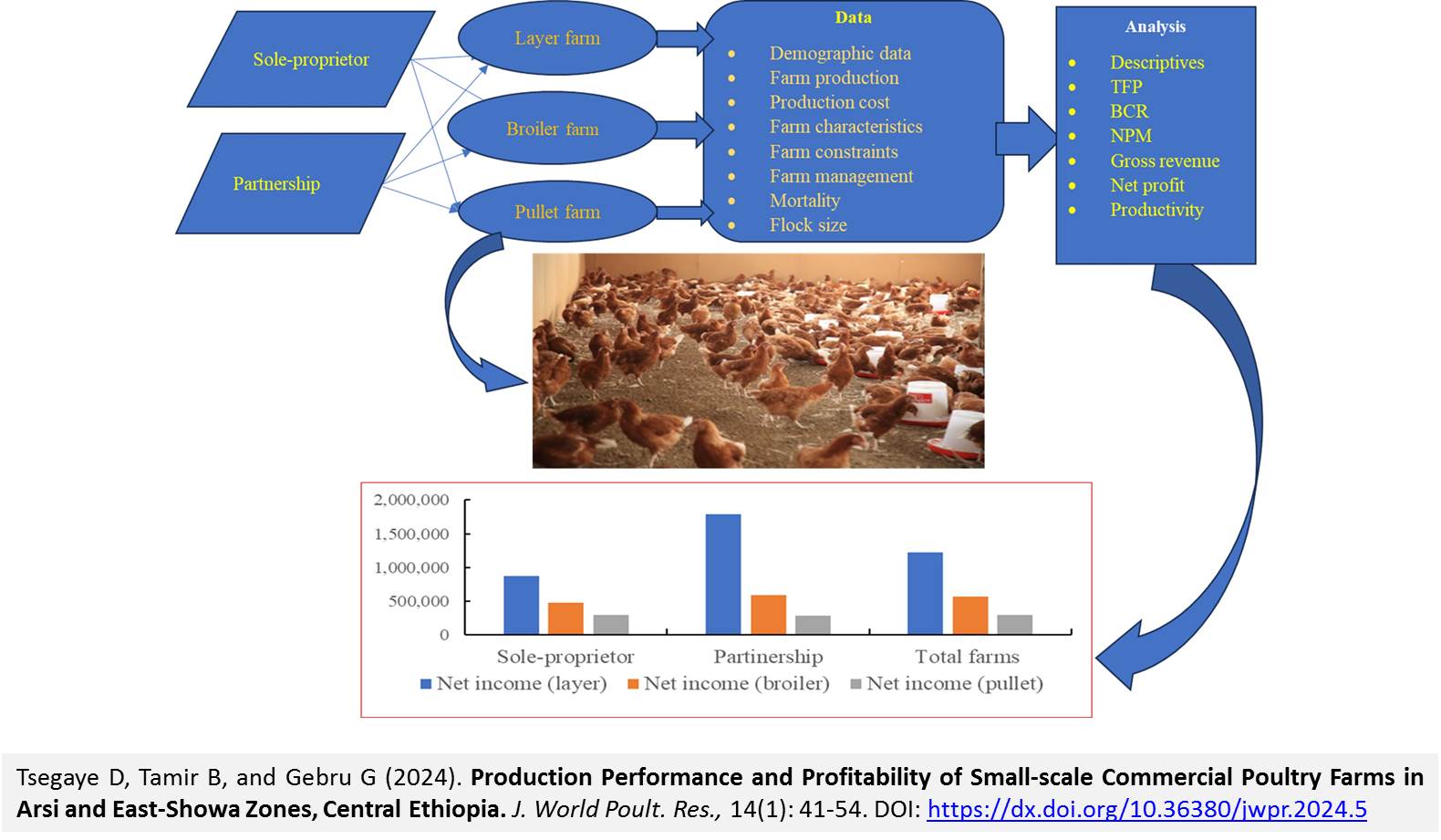 ABSTRACT: Poultry farming and the demand for chicken meat and eggs are growing due to their quality protein, essential nutrients, affordable price, and low investment cost. The current study was designed to investigate the productivity and profitability of small-scale commercial poultry enterprises. Data were collected from 221 poultry farms using a semi-structured questionnaire. The results were presented using descriptive statistics. Farm performances were measured by total-factor-productivity (TFP), benefit-cost-ratio (BCR), and net-profit-margin (NPM). The majority of the poultry farm owners were male (69.68%) and married (77.4%). Around 55.2% of poultry farmers aged 31-45 years. Group-owned farms had 4.59 ± 1.77 individual members. On average, a batch of layer chickens was kept for 17.0 ± 3.87 and 18.12 ± 4.25 months on individual and group-owned farms, respectively. Moreover, the mean selling ages of pullet and broiler chickens were 2.55 ± 0.71 and 2.18 ± 0.51 months, respectively. The flock size of layer chickens in sole-proprietor farms (562 ± 724) was significantly lower than in partnership farms (1165 ± 877). The average numbers of produced pullets by sole-proprietorship and partnership farms were 3177 ± 2360 and 3137 ± 1826, while the mean numbers of broilers produced were 2257 ± 1875 and 3269 ± 1669, respectively. The average egg and broiler weights in sole-proprietorship farms were significantly higher compared to group-owned farms. Annual egg production rates in individual and group-owned farms were 76.5% and 70.4%, respectively. The cost of feed, chicken, housing, labor, and medication were the top five production expenditures, while feed cost shares 60.4%. Egg producers had NPM, BCR, and TFP indices of 38.99%, 1.03, and 2.03, respectively, with notable differences by ownership types. The NPM, BCR, and TFP indices for broiler and pullet farms, respectively, were 42.78%, 0.93, and 1.93 for broilers and 35.21%, 0.92, and 1.67 for pullets. The results indicated that poultry firms performed optimally, regardless of ownership type. To further improve the efficiency and profitability of poultry enterprises, farmers need technical, finance, and management skills and input supply chains.
ABSTRACT: Poultry farming and the demand for chicken meat and eggs are growing due to their quality protein, essential nutrients, affordable price, and low investment cost. The current study was designed to investigate the productivity and profitability of small-scale commercial poultry enterprises. Data were collected from 221 poultry farms using a semi-structured questionnaire. The results were presented using descriptive statistics. Farm performances were measured by total-factor-productivity (TFP), benefit-cost-ratio (BCR), and net-profit-margin (NPM). The majority of the poultry farm owners were male (69.68%) and married (77.4%). Around 55.2% of poultry farmers aged 31-45 years. Group-owned farms had 4.59 ± 1.77 individual members. On average, a batch of layer chickens was kept for 17.0 ± 3.87 and 18.12 ± 4.25 months on individual and group-owned farms, respectively. Moreover, the mean selling ages of pullet and broiler chickens were 2.55 ± 0.71 and 2.18 ± 0.51 months, respectively. The flock size of layer chickens in sole-proprietor farms (562 ± 724) was significantly lower than in partnership farms (1165 ± 877). The average numbers of produced pullets by sole-proprietorship and partnership farms were 3177 ± 2360 and 3137 ± 1826, while the mean numbers of broilers produced were 2257 ± 1875 and 3269 ± 1669, respectively. The average egg and broiler weights in sole-proprietorship farms were significantly higher compared to group-owned farms. Annual egg production rates in individual and group-owned farms were 76.5% and 70.4%, respectively. The cost of feed, chicken, housing, labor, and medication were the top five production expenditures, while feed cost shares 60.4%. Egg producers had NPM, BCR, and TFP indices of 38.99%, 1.03, and 2.03, respectively, with notable differences by ownership types. The NPM, BCR, and TFP indices for broiler and pullet farms, respectively, were 42.78%, 0.93, and 1.93 for broilers and 35.21%, 0.92, and 1.67 for pullets. The results indicated that poultry firms performed optimally, regardless of ownership type. To further improve the efficiency and profitability of poultry enterprises, farmers need technical, finance, and management skills and input supply chains.
Keywords: Broiler, Layer, Poultry, Production, Profitability, Pullet
[Full text-PDF] [Crossref Metadata] [Scopus] [Export from ePrints]
|
|
Growth Performance in Laying Ducks Fed Protein Diets supplemented by Fresh Black Soldier Fly Larva |
Research Paper
Growth Performance in Laying Ducks Fed Protein Diets supplemented by Fresh Black Soldier Fly Larva
Gunawan A, Malik A, Hayati FN, Goa AS, Junaedi A, and Candra DW.
J. World Poult. Res. 14(1): 55-61, 2024; pii: S2322455X2400006-14
DOI: https://dx.doi.org/10.36380/jwpr.2024.6
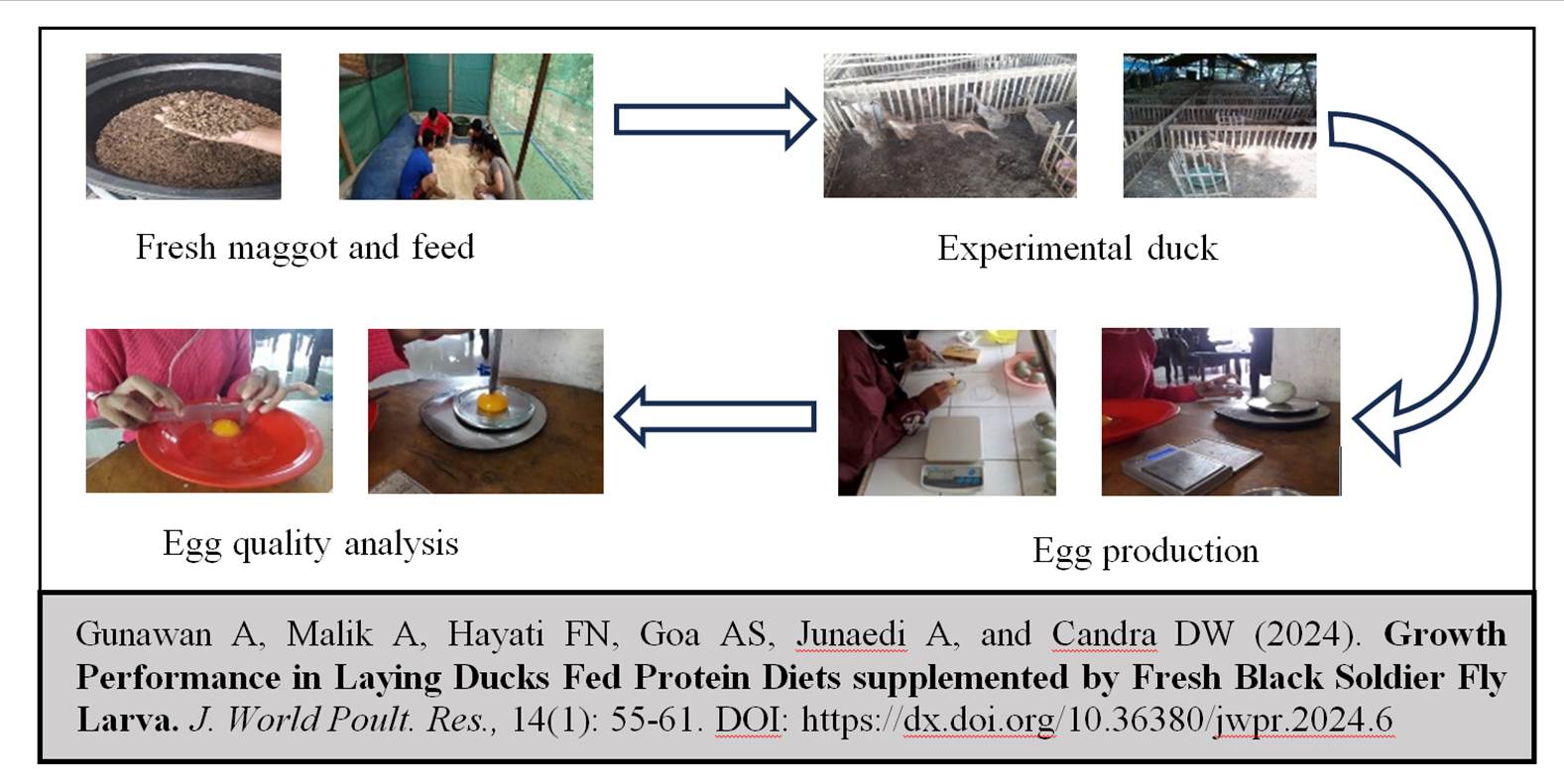 ABSTRACT: Live black soldier fly (BSF) maggots serve as an alternative feed for ducks and other poultry, boasting a protein composition similar to fish meal. The current study aimed to evaluate the effect of live BSF maggot supplementation as a protein source on increasing duck daily production, feed conversion ratio, and egg quality. A total of 120 female Alabio ducks aged 7 months were randomly divided into 24 cages with four treatments and six replications. Each cage consisted of five ducks. Performance parameters such as daily egg production, feed conversion ratio, and egg mass production were evaluated, along with the quality of duck eggs, including egg weight, yolk weight, yolk crude protein, and albumen crude protein. The results revealed that protein levels did not significantly affect feed consumption during the laying phase for ducks. However, the comparison of duck day production between treatment groups indicated that ducks receiving lower protein levels (13.43%) exhibited lower production, compared to those with higher protein levels (18.29%). Furthermore, feed protein content had a notable impact on egg weight, yolk weight, and albumen crude protein. The study demonstrated a significant increase in egg yolk weight, while the percentages of egg yolk weight and eggshell weight showed no significant differences. In conclusion, this research suggests that supplementing duck diets with live BSF maggots can enhance egg quality and performance parameters.
ABSTRACT: Live black soldier fly (BSF) maggots serve as an alternative feed for ducks and other poultry, boasting a protein composition similar to fish meal. The current study aimed to evaluate the effect of live BSF maggot supplementation as a protein source on increasing duck daily production, feed conversion ratio, and egg quality. A total of 120 female Alabio ducks aged 7 months were randomly divided into 24 cages with four treatments and six replications. Each cage consisted of five ducks. Performance parameters such as daily egg production, feed conversion ratio, and egg mass production were evaluated, along with the quality of duck eggs, including egg weight, yolk weight, yolk crude protein, and albumen crude protein. The results revealed that protein levels did not significantly affect feed consumption during the laying phase for ducks. However, the comparison of duck day production between treatment groups indicated that ducks receiving lower protein levels (13.43%) exhibited lower production, compared to those with higher protein levels (18.29%). Furthermore, feed protein content had a notable impact on egg weight, yolk weight, and albumen crude protein. The study demonstrated a significant increase in egg yolk weight, while the percentages of egg yolk weight and eggshell weight showed no significant differences. In conclusion, this research suggests that supplementing duck diets with live BSF maggots can enhance egg quality and performance parameters.
Keywords: Black soldier fly, Duck, Egg quality, Maggot, Performance, Source of protein
[Full text-PDF] [Crossref Metadata] [Scopus] [Export from ePrints]
|
|
Molecular Detection of Avian Poxvirus in Chickens and Pigeons of Diyala Province in Iraq |
Research Paper
Molecular Detection of Avian Poxvirus in Chickens and Pigeons of Diyala Province in Iraq
Faisal A, and Al-Azzawi A.
J. World Poult. Res. 14(1): 62-74, 2024; pii: S2322455X2400007-14
DOI: https://dx.doi.org/10.36380/jwpr.2024.7
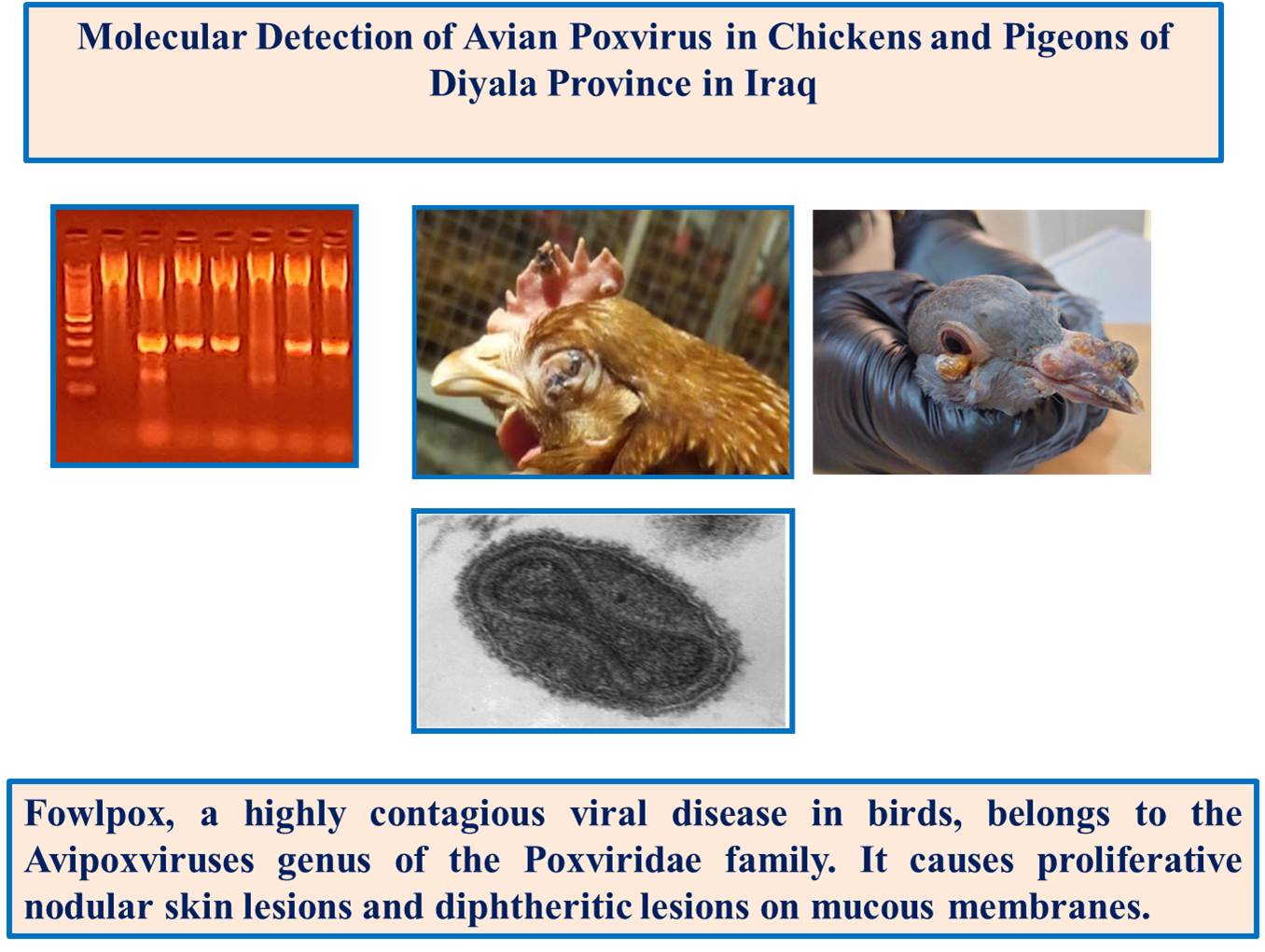 ABSTRACT: Fowlpox is an infectious viral disease affecting domestic and wild birds. The current study was conducted using PCR-based molecular detection to determine the avian pox virus (APV) and its genetic sequence. A total of 40 pigeons and 40 chickens suspected of APV were obtained from different bird markets. Following euthanasia, tissue samples were taken from the vents, eyes, wings, and beaks for molecular analysis. DNA extraction was focused on the core protein gene region (pb4). PCR results confirmed the presence of APV in all samples, generating specific cDNA bands of 329 bp. Four GenBank accession codes (OR670580, OR670581, OR670582, and OR670583) represented pigeon pox samples, whereas two GenBank accession numbers (OR619724 and OR619725) represented samples of fowlpox. A significant similarity of 99% was found by genetic analysis between the reference target sequences and the sequenced samples. In viral samples of fowlpox and avipoxvirus, nucleic acid variants (205 C > G and 204 T > C) were found with missense and silent effects on particular proteins (p.101Leu>Val and p.108Pro). Phylogenetic analysis organized the samples into clades representing fowlpox and pigeon pox viruses, showing close relationships with strains from different geographical regions. This study unequivocally demonstrates the susceptibility of both domestic and wild birds to avian pox, highlighting the pivotal role of phylogenetic analysis and molecular detection in elucidating novel perspectives on the genetic landscape of these viruses.
ABSTRACT: Fowlpox is an infectious viral disease affecting domestic and wild birds. The current study was conducted using PCR-based molecular detection to determine the avian pox virus (APV) and its genetic sequence. A total of 40 pigeons and 40 chickens suspected of APV were obtained from different bird markets. Following euthanasia, tissue samples were taken from the vents, eyes, wings, and beaks for molecular analysis. DNA extraction was focused on the core protein gene region (pb4). PCR results confirmed the presence of APV in all samples, generating specific cDNA bands of 329 bp. Four GenBank accession codes (OR670580, OR670581, OR670582, and OR670583) represented pigeon pox samples, whereas two GenBank accession numbers (OR619724 and OR619725) represented samples of fowlpox. A significant similarity of 99% was found by genetic analysis between the reference target sequences and the sequenced samples. In viral samples of fowlpox and avipoxvirus, nucleic acid variants (205 C > G and 204 T > C) were found with missense and silent effects on particular proteins (p.101Leu>Val and p.108Pro). Phylogenetic analysis organized the samples into clades representing fowlpox and pigeon pox viruses, showing close relationships with strains from different geographical regions. This study unequivocally demonstrates the susceptibility of both domestic and wild birds to avian pox, highlighting the pivotal role of phylogenetic analysis and molecular detection in elucidating novel perspectives on the genetic landscape of these viruses.
Keywords: Fowl pox, Gene, Pigeon pox, Polymerase Chain Reaction
[Full text-PDF] [Crossref Metadata] [Scopus] [Export from ePrints]
|
|
Research Paper
Effects of Moringa oleifera Leaf Meal on Local Guinea Fowl Breeder Hens’ Performance, Egg Quality, and Blood Parameters
Atitso PNK, N'nanle O, Voemesse K, Lare L, Attivi K, and Tete-Benissan KA.
J. World Poult. Res. 14(1): 75-87, 2024; pii: S2322455X2400008-14
DOI: https://dx.doi.org/10.36380/jwpr.2024.8
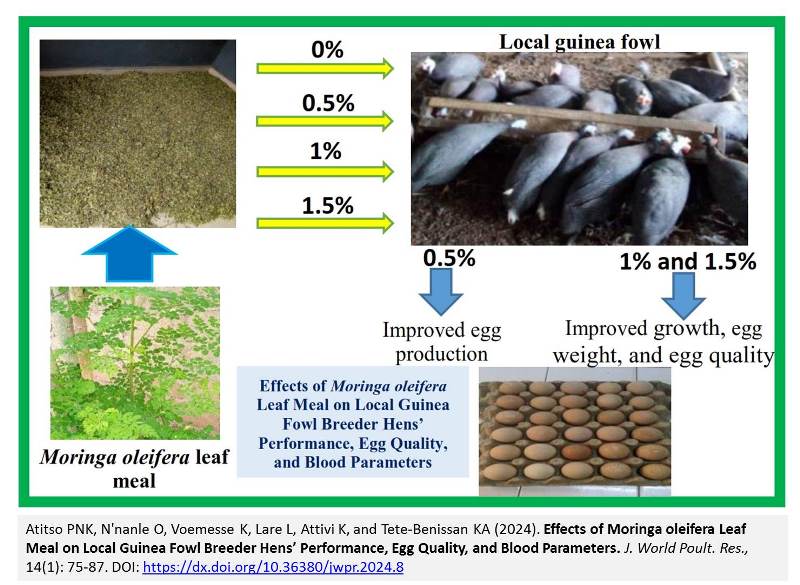 ABSTRACT: Breeding local guinea fowl has the potential to address protein malnutrition and alleviate poverty in West African countries. The current study aimed to examine the effects of incorporating Moringa oleifera leaf meal into the diet on hematology and biochemical parameters as well as the productive performance of local guinea fowl breeders in Togo. Thus, 512 local guinea fowls (22 weeks of age with an average weight of 1176.7 ± 2.9 g), comprising 384 females and 128 males, were examined for 31 weeks. The fowls were randomly assigned to four dietary groups, namely M0, M1, M2, and M3 containing 0%, 0.5%, 1%, and 1.5% of Moringa oleifera leaf meal in diets, respectively. Each group had 4 replicates of 32 fowls. During the study, feed intake, body weight, egg-laying rate, and feed conversion ratio were weekly recorded. Blood samples for hematology and biochemical analysis were taken from 12 females (3/replicate) at 34 and 50 weeks of age. Eggs were collected for the quality evaluation. Results showed that feed intake was comparable across all groups during the rearing period (23 to 33 weeks of age). However, it significantly decreased in fowls of the M2 and M3 during the laying period (34 to 50 weeks of age). The live weight of fowls in M3 was significantly higher than other groups before the laying period. The egg production, yolk ratio, and shell ratio of the birds in the M1 were like that of M0 and higher than that of M2 and M3. The feed conversion ratio was not significantly different between groups during the laying period. However, the albumen ratio and haugh unit were improved by feeding Moringa leaves especially at level 1.5%. The level of white blood cells and lymphocytes decreased by feeding the Moringa leaves at 1%. Neutrophils and platelet levels were comparable across groups. Total proteins, albumin, and transaminases increased in Moringa groups (M1, M2, M3), especially in M3. It was concluded that the use of Moringa oleifera leaves at 0.5% improved egg-laying performance in local guinea fowl. Moreover, 1% and 1.5% of incorporation improved the quality of eggs.
ABSTRACT: Breeding local guinea fowl has the potential to address protein malnutrition and alleviate poverty in West African countries. The current study aimed to examine the effects of incorporating Moringa oleifera leaf meal into the diet on hematology and biochemical parameters as well as the productive performance of local guinea fowl breeders in Togo. Thus, 512 local guinea fowls (22 weeks of age with an average weight of 1176.7 ± 2.9 g), comprising 384 females and 128 males, were examined for 31 weeks. The fowls were randomly assigned to four dietary groups, namely M0, M1, M2, and M3 containing 0%, 0.5%, 1%, and 1.5% of Moringa oleifera leaf meal in diets, respectively. Each group had 4 replicates of 32 fowls. During the study, feed intake, body weight, egg-laying rate, and feed conversion ratio were weekly recorded. Blood samples for hematology and biochemical analysis were taken from 12 females (3/replicate) at 34 and 50 weeks of age. Eggs were collected for the quality evaluation. Results showed that feed intake was comparable across all groups during the rearing period (23 to 33 weeks of age). However, it significantly decreased in fowls of the M2 and M3 during the laying period (34 to 50 weeks of age). The live weight of fowls in M3 was significantly higher than other groups before the laying period. The egg production, yolk ratio, and shell ratio of the birds in the M1 were like that of M0 and higher than that of M2 and M3. The feed conversion ratio was not significantly different between groups during the laying period. However, the albumen ratio and haugh unit were improved by feeding Moringa leaves especially at level 1.5%. The level of white blood cells and lymphocytes decreased by feeding the Moringa leaves at 1%. Neutrophils and platelet levels were comparable across groups. Total proteins, albumin, and transaminases increased in Moringa groups (M1, M2, M3), especially in M3. It was concluded that the use of Moringa oleifera leaves at 0.5% improved egg-laying performance in local guinea fowl. Moreover, 1% and 1.5% of incorporation improved the quality of eggs.
Keywords: Blood parameter, Breeder, Guinea fowl, Egg quality, Moringa oleifera
[Full text-PDF] [Crossref Metadata] [Scopus] [Export from ePrints]
|
} |
EDietary Protein Levels in the Small Intestine and Carcass Traits of Cross-Breed Chickens |
Research Paper
Dietary Protein Levels in the Small Intestine and Carcass Traits of Cross-Breed Chickens
Nuningtyas YF, Aulanni’am A, Sjofjan O, Nurgiartiningsih VMA, Furqon A, Lestari SP, and Natsir MH.
J. World Poult. Res. 14(1): 88-97, 2024; pii: S2322455X2400009-14
DOI: https://dx.doi.org/10.36380/jwpr.2024.9
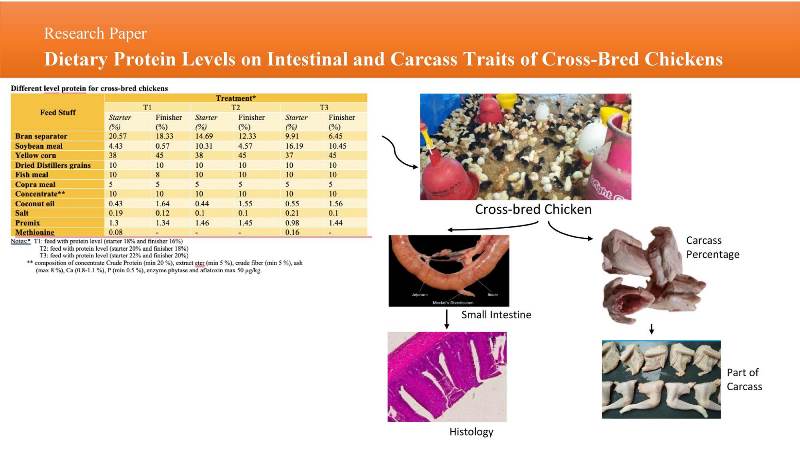 ABSTRACT: Protein is a source of nutrients that plays a significant role in biological processes. The current study aimed to evaluate the effects of feed with different protein levels on the pH and viscosity of the small intestine, ileum characteristics, and carcass traits of cross-breed chickens. A total of 160 cross-breed unsexed chicks aged 2 days were divided into three treatments (T1-T3), each consisting of 6 replications with 9 chicks per replication, consisting of a diet with protein level (T1; starter 18% and finisher 16%;), a diet with protein level (T2; starter 20% and finisher 18%), and a diet with protein level (T3; starter 22% and finisher 20%). Cross-breed chickens were crossed between Bangkok males and Lohmann laying hens. The variables were analyzed, including pH and viscosity of digesta, ileum characteristics consisting of total villous, height of villous, and depth of crypt. The carcass percentages consisting of the carcass, breast, thicks, wings, and back were measured. The research was analyzed using a completely randomized design. The results indicated that different protein levels in treatments were significantly different in total villous, height of villous, and depth of crypt but did not indicate a significant difference in pH and viscosity. Furthermore, the treatments have a significant difference in the carcass percentage and thick percentage but did not significantly affect the breast, wings, and back. It can be concluded that 22% crude protein in the starter and 20% crude protein in the finisher produced the greatest results in the intestinal characteristics and also in the carcass percentage of cross-breed chickens.
ABSTRACT: Protein is a source of nutrients that plays a significant role in biological processes. The current study aimed to evaluate the effects of feed with different protein levels on the pH and viscosity of the small intestine, ileum characteristics, and carcass traits of cross-breed chickens. A total of 160 cross-breed unsexed chicks aged 2 days were divided into three treatments (T1-T3), each consisting of 6 replications with 9 chicks per replication, consisting of a diet with protein level (T1; starter 18% and finisher 16%;), a diet with protein level (T2; starter 20% and finisher 18%), and a diet with protein level (T3; starter 22% and finisher 20%). Cross-breed chickens were crossed between Bangkok males and Lohmann laying hens. The variables were analyzed, including pH and viscosity of digesta, ileum characteristics consisting of total villous, height of villous, and depth of crypt. The carcass percentages consisting of the carcass, breast, thicks, wings, and back were measured. The research was analyzed using a completely randomized design. The results indicated that different protein levels in treatments were significantly different in total villous, height of villous, and depth of crypt but did not indicate a significant difference in pH and viscosity. Furthermore, the treatments have a significant difference in the carcass percentage and thick percentage but did not significantly affect the breast, wings, and back. It can be concluded that 22% crude protein in the starter and 20% crude protein in the finisher produced the greatest results in the intestinal characteristics and also in the carcass percentage of cross-breed chickens.
Keywords: Carcass, Cross-breed chicken, Feed, Intestinal characteristic, Protein
[Full text-PDF] [Crossref Metadata] [Scopus] [Export from ePrints]
|
|
Research Paper
Identification of Extremely Virulent Infectious Bursal Disease Virus Via Molecular and Histological Methods in Broiler Chickens
Nasser AT, Al-Azzawi A, Al-Agele R, and Al-Ajeeli K.
J. World Poult. Res. 14(1): 98-112, 2024; pii: S2322455X2400010-14
DOI: https://dx.doi.org/10.36380/jwpr.2024.10
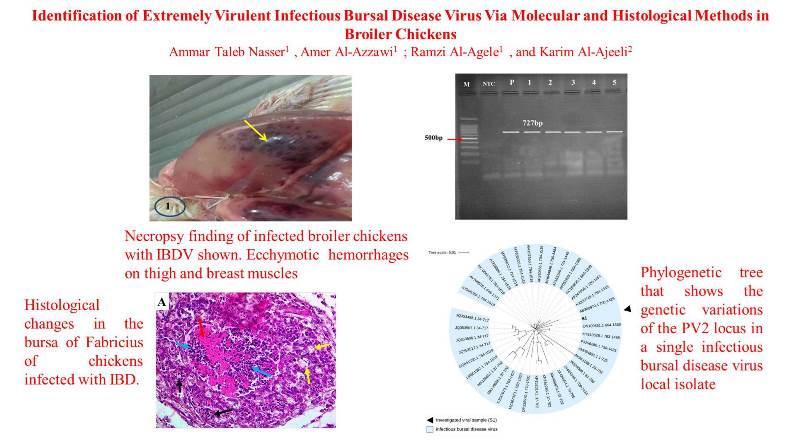 ABSTRACT: Infectious bursal disease (IBD) is caused by an RNA virus belonging to the Avibirnavirus genus within the Birnaviridae family. The global prevalence of infectious bursal disease virus (IBDV) is a significant concern, affecting birds of all ages. Birds infected with IBDV exhibit symptoms, such as depression, bleeding in the thighs and pectoral muscles, and enlargement of the bursa. This study aimed to identify predominant IBDV serotypes using molecular methods and to gain insights into the resulting pathological conditions in infected chickens. Additionally, the study investigated the viral sequence and the relationship between a local Diyala isolate and reference strains from the Genebank. In the current study, the IBDV was isolated from broiler chickens aged 2-3 weeks from 15 farms in the Diyala Governorate of Iraq. A total of 15 samples, each from a different farm, were collected. Necropsy samples were obtained from various organs of broiler chickens, including the bursa of Fabricius, lungs, liver, and kidneys. Specific primers targeting the VP2 gene were used for reverse transcription-polymerase chain reaction (RT-PCR) analysis. The RT-PCR analysis yielded a 727 bp fragment, confirming the presence of IBDV in 10 out of the 15 samples. One strain was assigned the accession number LC498531 in the NCBI database. Phylogenetic analysis using the neighbor-joining tree program revealed three distinct groups. All examined regional samples (S1) were situated within the constructed tree. Five samples formed a specific group, indicating a close relationship. Histological examination of the tissues showed visible alterations such as degeneration, necrosis, and infiltration of inflammatory cells, particularly heterophils, providing clear evidence of the disease. In conclusion, this study confirmed the presence of IBDV in broiler chickens from multiple farms in Iraq’s Diyala Governorate, highlighting distinct clustering patterns in viral sequences. Moreover, the study confirmed the virus's presence using conventional RT-PCR, with histological examination supporting the findings.
ABSTRACT: Infectious bursal disease (IBD) is caused by an RNA virus belonging to the Avibirnavirus genus within the Birnaviridae family. The global prevalence of infectious bursal disease virus (IBDV) is a significant concern, affecting birds of all ages. Birds infected with IBDV exhibit symptoms, such as depression, bleeding in the thighs and pectoral muscles, and enlargement of the bursa. This study aimed to identify predominant IBDV serotypes using molecular methods and to gain insights into the resulting pathological conditions in infected chickens. Additionally, the study investigated the viral sequence and the relationship between a local Diyala isolate and reference strains from the Genebank. In the current study, the IBDV was isolated from broiler chickens aged 2-3 weeks from 15 farms in the Diyala Governorate of Iraq. A total of 15 samples, each from a different farm, were collected. Necropsy samples were obtained from various organs of broiler chickens, including the bursa of Fabricius, lungs, liver, and kidneys. Specific primers targeting the VP2 gene were used for reverse transcription-polymerase chain reaction (RT-PCR) analysis. The RT-PCR analysis yielded a 727 bp fragment, confirming the presence of IBDV in 10 out of the 15 samples. One strain was assigned the accession number LC498531 in the NCBI database. Phylogenetic analysis using the neighbor-joining tree program revealed three distinct groups. All examined regional samples (S1) were situated within the constructed tree. Five samples formed a specific group, indicating a close relationship. Histological examination of the tissues showed visible alterations such as degeneration, necrosis, and infiltration of inflammatory cells, particularly heterophils, providing clear evidence of the disease. In conclusion, this study confirmed the presence of IBDV in broiler chickens from multiple farms in Iraq’s Diyala Governorate, highlighting distinct clustering patterns in viral sequences. Moreover, the study confirmed the virus's presence using conventional RT-PCR, with histological examination supporting the findings.
Keywords: Broiler chicken, Bursal enlargement, Infectious bursal disease, RT-PCR
[Full text-PDF] [Crossref Metadata] [Scopus] [Export from ePrints]
|
|
Research Paper
Effects of Natural Guard Liquid (an Essential Oil-Based Product) on Growth Performance, Hematological Profile, and Antibody Response to Newcastle Disease Virus in Broiler Chickens
Merdana IM, Maharanthi KN, Sudimartini LM, Sumadi IK, Babikian YHS, Babikian HY, Laiman H, Haliman RW, Yen TI, Kristina, Efendy HY, Setiasih NLE, and Ardana IBK.
J. World Poult. Res. 14(1): 113-123, 2024; pii: S2322455X2400011-14
DOI: https://dx.doi.org/10.36380/jwpr.2024.11
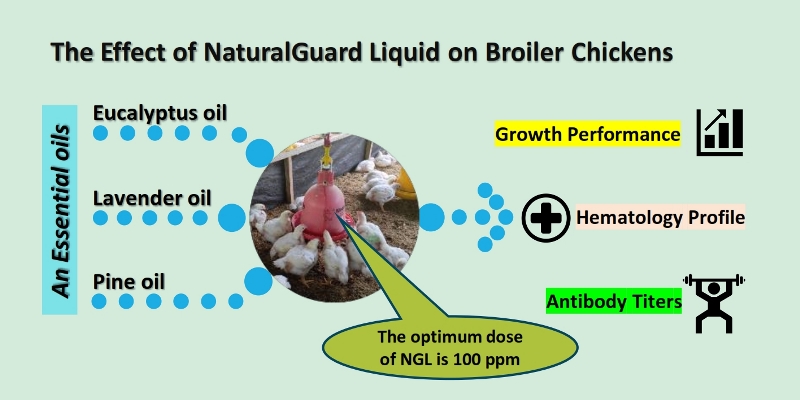 ABSTRACT: Natural guard liquid (NGL) is an immunomodulator consisting of an essential oil blend (lavender oil, eucalyptus oil, and pine oil) that can improve the immunity (IgG) of animals. The objective of this research was to assess the effectiveness of a mixture of NGL comprising of essential oil (eucalyptus, lavender, and pine oil) on growth performance, hematological profile, and antibody titer response to the Newcastle disease virus (NDV) in Lohman strain broiler chickens. A total of 400-day-old unsexed broiler chickens with an average weight of 42.48 ± 2.08 g were randomly distributed into four groups, each comprising two replications with 50 chicks. The control group, T0, received no essential oil, while other treatment groups, T1, T2, and T3, were administered NGL at 80, 100, and 200 ppm, respectively. The mixture was administered in drinking water for 30 days. The animals had received vaccinations at the Hatchery, including active NDV, inactive NDV, and Gumboro. Regular recordings were made for feed consumption, water intake, mortality, and body weight. Blood samples for routine hematological examination (hemoglobin, erythrocytes, packed cell volume, erythrocyte index, leucocytes, and differential leucocytes) and immune parameter (NDV antibody titer) assessment were collected at the onset as well as after 15 and 30 days of treatment. The hemoglobin levels, erythrocytes, total leukocytes, lymphocytes, and Heterophil-lymphocyte index showed significant differences in groups T1 and T2 compared to T0. While the NDV antibody titer showed a significant difference at T2 compared to T0, it was not significantly different at T1 and T3. The best results and performance was indicated in T2 (100 ppm), characterized by body weight (1,839 g), and feed conversion ratio (1.573). The hematological profile in the T2 group included hemoglobin (11.78 g/dL), total erythrocytes (2.82 ×106 u/L), total leukocytes (52.67 ×103 u/L]), and the NDV antibody titer (48 ± 10.20) in the fifth week. In conclusion, the optimum dose of NGL is 100 ppm, which significantly influences growth performance, hematological profile, and antibody titer against NDV.
ABSTRACT: Natural guard liquid (NGL) is an immunomodulator consisting of an essential oil blend (lavender oil, eucalyptus oil, and pine oil) that can improve the immunity (IgG) of animals. The objective of this research was to assess the effectiveness of a mixture of NGL comprising of essential oil (eucalyptus, lavender, and pine oil) on growth performance, hematological profile, and antibody titer response to the Newcastle disease virus (NDV) in Lohman strain broiler chickens. A total of 400-day-old unsexed broiler chickens with an average weight of 42.48 ± 2.08 g were randomly distributed into four groups, each comprising two replications with 50 chicks. The control group, T0, received no essential oil, while other treatment groups, T1, T2, and T3, were administered NGL at 80, 100, and 200 ppm, respectively. The mixture was administered in drinking water for 30 days. The animals had received vaccinations at the Hatchery, including active NDV, inactive NDV, and Gumboro. Regular recordings were made for feed consumption, water intake, mortality, and body weight. Blood samples for routine hematological examination (hemoglobin, erythrocytes, packed cell volume, erythrocyte index, leucocytes, and differential leucocytes) and immune parameter (NDV antibody titer) assessment were collected at the onset as well as after 15 and 30 days of treatment. The hemoglobin levels, erythrocytes, total leukocytes, lymphocytes, and Heterophil-lymphocyte index showed significant differences in groups T1 and T2 compared to T0. While the NDV antibody titer showed a significant difference at T2 compared to T0, it was not significantly different at T1 and T3. The best results and performance was indicated in T2 (100 ppm), characterized by body weight (1,839 g), and feed conversion ratio (1.573). The hematological profile in the T2 group included hemoglobin (11.78 g/dL), total erythrocytes (2.82 ×106 u/L), total leukocytes (52.67 ×103 u/L]), and the NDV antibody titer (48 ± 10.20) in the fifth week. In conclusion, the optimum dose of NGL is 100 ppm, which significantly influences growth performance, hematological profile, and antibody titer against NDV.
Keywords: Antibody titer, Broiler chicken, Growth performance, Hematological profile, Natural Guard Liquid
[Full text-PDF] [Crossref Metadata] [Scopus] [Export from ePrints]
Previous issue | Next issue | Archive
This work is licensed under a Creative Commons Attribution 4.0 International License (CC BY 4.0).![]()
